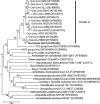Cultivation of a Synergistetes strain representing a previously uncultivated lineage
- PMID: 20074237
- PMCID: PMC2916210
- DOI: 10.1111/j.1462-2920.2009.02135.x
Cultivation of a Synergistetes strain representing a previously uncultivated lineage
Abstract
Subgingival plaque samples obtained from human subjects with periodontitis, shown to include previously uncultivable members of the phylum Synergistetes, were used to inoculate Cooked Meat Medium (CMM). The presence of Cluster A (uncultivable) Synergistetes was monitored by fluorescent in situ hybridization (FISH) and quantitative PCR (Q-PCR). Cluster A Synergistetes were found to grow in CMM in co-culture with other plaque bacteria and growth was stimulated by the addition of mucin and serum. Plaque samples were also used to inoculate Blood Agar (BA) plates and growth of Cluster A Synergistetes was revealed after anaerobic incubation, by colony hybridization with specific probes. Surface growth on the plates in regions identified by colony hybridization was harvested and used to inoculate fresh plates, thus enriching for Cluster A Synergistetes. Cross-streaks of other plaque bacteria were also used to stimulate Synergistetes growth. In the early passages, no discrete Synergistetes colonies were seen, but after eight passages and the use of cross-streaks of other bacteria present in the enriched community, colonies arose, which consisted solely of Cluster A Synergistetes cells, as determined by 16S rRNA gene PCR and cloning. This is the first report of the successful culture of a member of the uncultivable branch of this phylum.
Figures









References
-
- Baena S, Fardeau ML, Ollivier B, Labat M, Thomas P, Garcia JL, et al. Aminomonas paucivorans gen. nov., sp. nov., a mesophilic, anaerobic, amino-acid-utilizing bacterium. Int J Syst Bacteriol. 1999;49(3):975–982. - PubMed
-
- Beighton D, Smith K, Glenister DA, Salamon K, Keevil CW. Increased degradative enzyme production by dental plaque bacteria in mucin-limited continuous culture. Microb Ecol Health Dis. 1988;1:85–94.
-
- Bernard KA, Ongsansoy E, Ng B, Citron DM, Warren YA, Marchandin H, et al. 107th General Meeting, American Society for Microbiology. Toronto, Canada: 2007. Characterization of Gram negative anaerobes, closest to the genus Synergistes.
Publication types
MeSH terms
Substances
Grants and funding
LinkOut - more resources
Full Text Sources
Molecular Biology Databases

